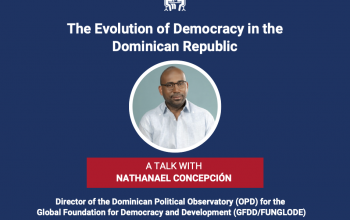news
“The Global Financial Crisis: One Decade Later”, an article by Dr. Leonel Fernández
October 18, 2018
One decade ago, in 2008, with the failure of the Lehman Brothers Investment Bank, the world was impacted by the most profound and severe world economic crisis since the Great Depression of the 1930s.
The financial crisis, which later transformed into a global economic recession and contributed to a terrible debt crisis in Europe, began in the strangest way. It was provoked by the explosion of a bubble created and related to the real estate and mortgage
markets in the United States.
Due to the financial crisis experienced during the 1990s in Mexico, Brazil, Russia and Asia, a great influx of capital began to be transferred to the U.S. financial system. This, in turn, allowed for the creation of the liquid assets used by the banks, with the encouragement of the U.S. Federal government, to facilitate high-risk loans to low-income families.
In the beginning, of course, this policy seemed reasonable. After
all, that’s what governments are supposed to do: facilitate policies so that citizens can satisfy their basic needs, such as the purchase of a home.
However, the situation became complicated due to the introduction of new banking practices, which the experts called financial innovations. Included among these new innovations was the conversion of home mortgage guarantees into financial assets that were later placed for sale in international banks.
Why did these banks risk purchasing these financial assets, with mortgage guarantees from families that did not have the capacity to meet their mortgage obligations? Because included among the financial innovations was the guarantee of these operations through alleged insurance mechanisms. However, there were no such mechanisms such as the credit default swaps of the collateralized debt obligations.
All these mechanisms were part of a great banking system known
as “shadow banking.” Investment banks and the hedge funds were an integral part of this system.
The jump in demand of new housing generated an increase in the real estate market. In light of this situation, consumers used their homes to obtain second and third mortgages in order to receive new loans.
By facing various debts at the same time and, because they were high-risk debtors, they failed to meet their financial obligations to the banks
which, in turn, inevitably proceeded to carry out foreclosures. In total, more than nine million home owners lost their homes.
By executing these foreclosures, and in spite of the drop in the price of the real estate market, there was a significant drop in the purchase of new homes. This impacted the banking system to such an extent that it began to suffer a lack of liquidity which, at the same time, generated a crisis in the approval of new loans. This undoubtedly
impacted the economy in general.
From the Mortgage Crisis to the Financial Crisis
The lack of liquidity, and the drop in the issuance of new loans, was transferred to the European banks which had made financial transactions with its U.S. partners. This initial mortgage and real estate crisis in the United States turned into a full-fledged global banking crisis.
The immediate impact of this new financial crisis generated a
drop in the growth of the global economy, and a drop in international trade. Tax revenues dropped significantly in various countries and, of course, this brought about a significant drop in public investment.
The virtual paralysis of the economy provoked serious social protests in various countries throughout the world.
Discontent, dissatisfaction and popular resentment was experienced in many places throughout the world.
In the
political realm, there was extreme discontent with local governments. During various electoral processes throughout the world, the parties in government were severely punished at the voting booths. It appeared to be a true revolt against the established order.
If the Social Democrats were in power, in came the Christian Democrats; and vice versa. But, at the same time, it was the moment when extreme right groups, racists, xenophobes and those who opposed new
immigration policies found the support they needed thanks to the social discontent generated by the financial crisis.
The appearance of new political forces, such as Podemos y Ciudadanos in Spain, or Syriza, in Greece, grew thanks to the social struggles provoked by the global financial crisis.
The Arab Spring, which spread like wildfire through the Middle East – stretching from Tunisia, Egypt, Bahrain, Oman, Lybia and Syria – was
also a direct result of the financial global crisis.
In order to confront the global financial crisis, the governments immediately proceeded to invest billions of dollars in rescue operations carried out by the banks. The idea was to support them with the needed assets and thus provide credit to the economic sectors.
At the same time, new financial regulations were introduced to recapitalize credit institutions. Also, stronger banking regulation and
accountability measures were introduced.
The goal was to stabilize and generate confidence in the economic agents in order to encourage economic growth, stimulate investment, and lower unemployment rates.
The Results Were Ambiguous
In the United States, with the introduction of an expansive monetary policy introduced during the Barack Obama Administration, efforts were made to place a tourniquet on the financial hemorrhage.
The economy stabilized, moderate growth was experienced, and unemployment dropped.
However, Europe did not react the same way. When similar measures were applied in that part of the world – to control spending and introduce austerity measures – the lack of economic growth lasted another eight years, unemployment did not drop as expected, and social unrest remained a constant.
A Decade Later
Ten years after the outbreak of
the most serious crisis faced by the world economy in the last 90 years, the principal economic and social indicators revealed that today the banking system has become stronger, there are more supervision mechanisms, greater levels of capitalization and a drop in the issuance of loans to high-risk customers.
Estimates indicate that the U.S. economy could grow this year, 2018, by 3%. This has not occurred in more than a decade. Unemployment has dropped to such levels
that it is believed that the country is experiencing full employment. Inflation has also dropped.
There has also been an increase in salary levels and a significant improvement in consumer confidence. There is also confidence in the stock markets, stocks have gone up in value, investments have jumped and, again, the dollar has strengthened.
At the end of this 10-year period, when the Great Global Recession began, there has been a slow recovery process.
With the current stable climate, there is a global optimism regarding the global economy.
However, dark clouds are still looming in the horizon. One specific factor that currently generates serious concern is the jump in the debt accumulated by the world’s most important developed nations.
Beginning in 2008, global public and private debt has increased by more than US$70 trillion, a number that literally equivalent to the world’s
Gross Internal Product.
Another element has to do with the financial deregulation that is now being applied, as a possible mechanism that will facilitate financial transactions. However, the lack of regulation was precisely one of the culprits that most impacted the world banking system.
For some analysts, President Donald Trump’s policies to lower taxes for companies, represents a positive short-term factor to stimulate investment. However,
at the medium and long-range terms this situation will increase the debt, generate more fiscal deficit – especially now that the Federal Reserve has begun to raise interest rates – placing the financial system, once more, in a fragile position.
Should this trajectory continue, according to a recent article published by The New York Times the payment of the debt alone, by the U.S. federal government, will be equivalent to US$900 billion per year, an amount that is greater
than the US$700 billion that currently makes up the military budget.
The current trade war between the United States and China, which implies an increase in the payment of tariffs for export and import products, should it continue, will inevitably lead to a drop in international trade.
Finally, 10 years after the global financial crisis, the recovery levels reached due to the exorbitant increase of the debt, should not contribute to the repetition of
the same errors that, the truth is, encouraged the crisis.
If we do not learn from these historical lessons, as has been pointed out by Spanish philosopher George Santayana, we will be condemned to repeat them.






